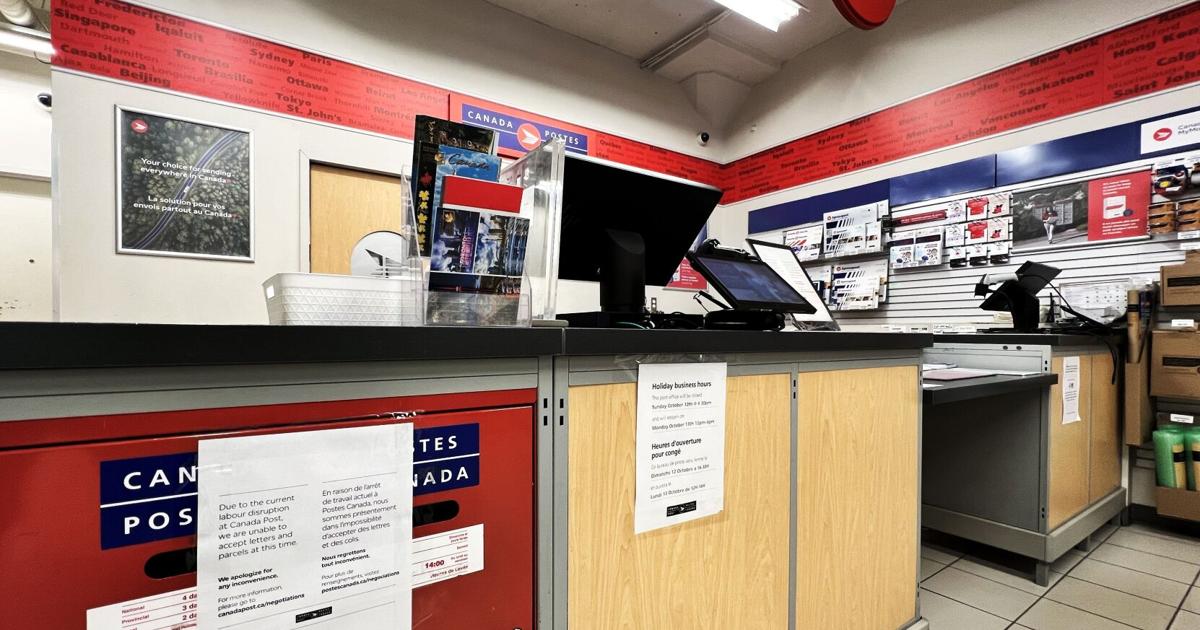Imagine walking into a Canada Post office, but instead of mailing a letter to a friend, you’re actually there to take out a mortgage.
In the thick of the labour dispute between Canada Post and the Canadian Union of Postal Workers (CUPW), a decades-old debate concerning the future of post offices across the country has once again taken the stage: Should Canada Post enter the banking business?
The question has resurfaced among key stakeholders amidst the ongoing postal worker job action and after Canada Post reported it is hemorrhaging $1 billion every year due to a decline in mail and parcel delivery volumes.
On Thursday evening, CUPW announced it is moving from a nationwide walkout to rotating strikes while continuing to “struggle for good collective agreements and a strong public postal service.”
In its “Hands Off My Post Office!” campaign, CUPW insists that postal banking could save the beleaguered Crown corporation by becoming a significant source of profits while helping Canadians in remote communities get better access to financial services.
Postal banking already exists in many other countries including France, with La Banque Postale serving 64 million customers and bringing in €1.2 billion ($1.9 billion) in net profit last year, and Switzerland, where PostFinance offers a full range of services, from personal loans to investment advice.
According to the Universal Postal Union, a United Nations agency, 84 per cent of postal operators globally offer some form of financial services. The median revenue from financial services across postal operators is 19 per cent of total revenues, a spokesperson for the agency said, adding that revenues from banking have been growing in recent years.
“What postal banking has done for all sorts of postal administrations is let them get this money from financial services and support the rest of the stuff that the post office wants to do,” Peter Denley, national director of the central region at CUPW, told the Star.
Denley said he believes Canada Post has “the opportunity to provide multiple services at a profit instead of one service that’s struggling.”
But others, including Ian Lee, an associate professor of management at Carleton University, don’t think postal banking would solve Canada Post’s current financial problems. He said he worries it would cost a lot to execute and believes that Canada Post couldn’t survive the crushing competition from Canada’s Big Six banks.
“The premise is that banking is, really, a simple industry. It’s not. It’s the exact opposite,” said Lee.
“These mega gigantic banks in the States … have never entered Canada, and there’s a reason why. It’s because they understand that the six Canadian banks are so dominant, are so strong. They’ve been there over 150 years.”
Canada has 16 U.S.-based bank subsidiaries and branches, according to the Canadian Bankers Association, but they are not major players in the market.
In an emailed statement to the Star, Canada Post spokesperson Lisa Liu declined to comment specifically on the union’s proposals, given that negotiations are underway.
“We need to fix our core delivery service so that we can reduce costs and grow revenues,” Liu wrote.
“That has been our focus throughout negotiations, such as our proposals to add weekend parcel delivery. The Government has been clear that we need to make significant changes to align with the current delivery needs of Canadians and return to financial sustainability, and not continue to be a drain on the taxpayers.”
Canada Post tries out banking
Canada Post has already made a foray into financial services but it is minimal in comparison to a slew of products and offerings provided by La Banque Postale and PostFinance.
Through its partnership with MoneyGram, Canada Post allows Canadians to transfer up to $100 for a flat fee of $4 from a post office or online.
In March, the company joined forces with Canadian fintech KOHO to launch spending and savings accounts where holders can earn cash back and interest while building credit. The MyMoney Account program also offers no-fee account options, unlike some Canadian banks.
Before partnering with KOHO, Canada Post discontinued a consumer lending program with TD Bank in 2023. Neither Canada Post nor TD provided reasons for ending the program at the time.
Denley, of CUPW, couldn’t share the number of MyMoney Account holders to date, citing confidentiality, but said “it was in the thousands several months ago.” Canada Post did not respond to the Star’s question regarding the number of MyMoney users.
Denley argued there is an opportunity for Canada Post to move away from working with KOHO and form a wholly-owned public bank so it can take advantage of its revenues to subsidize other postal services, including mail delivery, community hubs and senior check-ins, where postal workers would go door to door to ask seniors how they are doing and offer to send messages to their family or care providers.
“We think this is a good start, but it certainly isn’t the end game, and certainly can be amplified and increased very rapidly,” he said.
Denley said Canada Post rolled out the MyMoney Account program with KOHO early in the bargaining process, but management has refused to talk about further expansion of financial services when CUPW has brought it up during negotiations.
“Canada Post has to talk and work with the union to move this forward.”
Faye Lucas, senior director of legal and head of consumer trust at KOHO, said the company is keeping a close eye on the labour dispute while making sure MyMoney members have the support they need.
“Right now, we don’t expect the strike to affect the program,” Lucas said in a statement Wednesday.
Commissioner dismisses postal banking
Canada Post said it has looked into postal banking alongside CUPW and the federal government “a number of times,” citing studies, including the Industrial Inquiry Commission report published in May.
In the report, commissioner William Kaplan concluded that “given the financial crisis, Canada Post must focus on saving its core business, not on providing new services.”
Kaplan highlighted that Canadians increasingly bank on their phones, and Canadian banks and trust companies have been shutting down branches.
“What possible reason could there be to turn thousands of post office stations into financial institutions, even if the many other challenges of entering this heavily regulated mature moated business could somehow be surmounted?” Kaplan wrote.
Kaplan also noted that a total of 94 submissions to the commission were received from an Indigenous band council and municipal governments.
His report stated that “numerous” stakeholders advocated for Canada Post to diversify and generate new streams of revenue, including through postal banking.
Advocacy, not-for-profit, charitable and related organizations, making up 13 submissions, also expressed support for postal banking.
Simon Enoch, a senior researcher at the Canadian Centre for Policy Alternatives, said he believes Kaplan should have given more weight to the potential role of postal banking in saving Canada Post.
“For a place like Canada that has a banking oligopoly and a telecom oligopoly, maybe a public option provided by the post office would be a welcome addition,” said Enoch.
“The infrastructure that the post office has as a public service, particularly for banking, and being able to provide actual physical branch services in remote rural areas, to me it seems like a win-win situation,” he added.
“As we would expect any other business to expand to improve its revenue, I don’t see why Canada Post shouldn’t be allowed to explore those options as well.”



